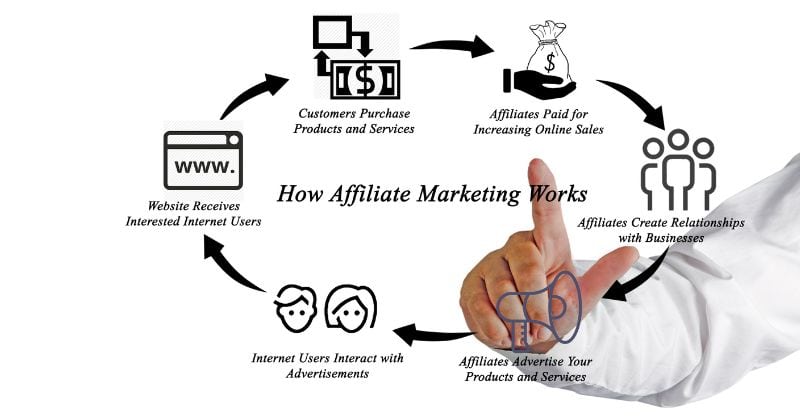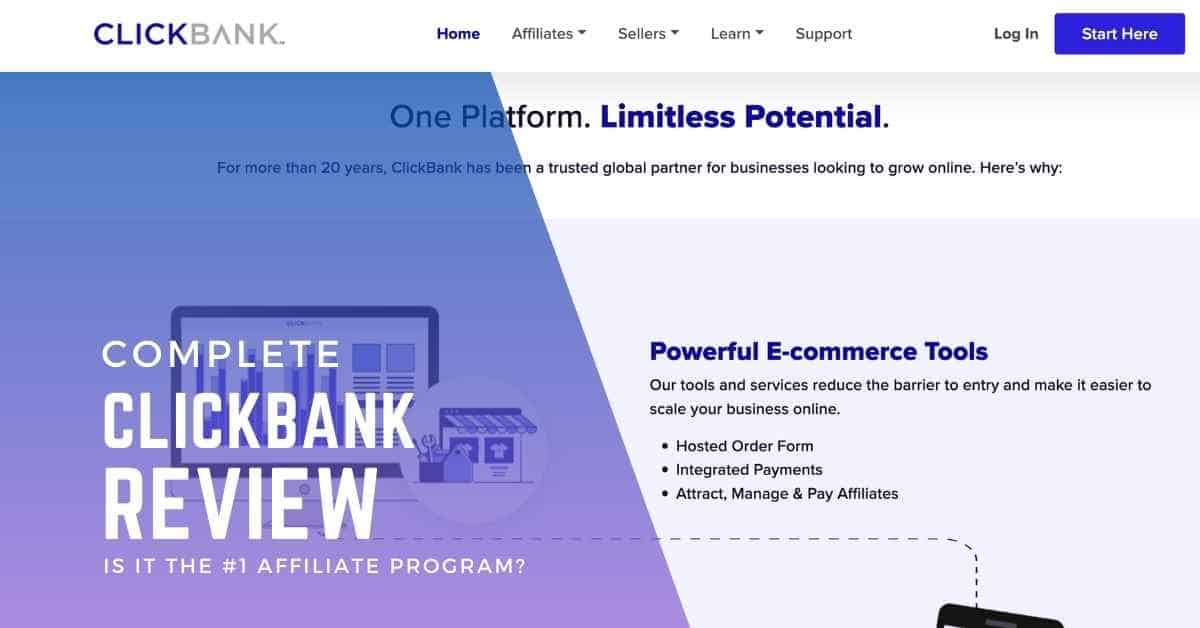Want to earn money online by promoting products you believe in? That’s affiliate marketing. You promote products through your unique affiliate blog links, earning a commission for each sale. It’s a real way to make money, and it’s right at your fingertips.
But it’s not always easy. Picking the right products and creating content that sells—these challenges are real. I’ve been there, and as a successful digital marketer and blogger, I’ve tackled them head-on. You’re in the right place to find practical solutions to these problems.
Why focus on affiliate marketing? Because it’s a solid way for bloggers, marketers, and entrepreneurs to build income without breaking the bank. This is your next step if you’re hustling to make online revenue. Let’s get to the strategies that will make you successful in this lucrative field.
Key Takeaways
- Understand affiliate marketing’s core concept, including roles and revenue sharing.
- Discover strategies for effective promotion and traffic generation through various channels.
- Master the use of tracking links and cookies for accurate referral monitoring.
- Learn to select and endorse products authentically, integrating affiliate links naturally.
- Identify effective techniques for trust-building and transparency in affiliate relationships.
What is Affiliate Marketing?
Affiliate marketing is a performance-based marketing strategy where businesses reward individuals, known as affiliates, for driving traffic or sales to their website through the affiliate’s marketing efforts.
Affiliates earn commissions by promoting products or services using unique tracking links. This model benefits both parties by increasing revenue and broadening customer reach.

Learn the Basics of Affiliate Marketing
Affiliate marketing involves a partnership between advertisers and affiliates. Advertisers are individuals or businesses with products or services to sell, while affiliates are independent marketers promoting these offerings through various channels.
The fundamental concept behind affiliate marketing is simple: affiliates earn a commission for each sale or referral they generate for the advertiser. This commission can be a fixed amount or a percentage of the sale value. It’s important to note that the advertiser does not employ affiliates but acts as independent contractors.
How Advertisers Use Affiliates for Promotion
Advertisers rely on affiliates to expand their reach and drive sales. Advertisers can tap into new audiences and benefit from their promotional efforts by partnering with affiliates. Affiliates use content creation, social media promotion, email marketing, and search engine optimization to attract potential customers to the advertiser’s website.
One of the critical advantages for advertisers is that they only pay commissions when desired actions occur. This means they can effectively track their return on investment (ROI) and minimize advertising costs since they only pay when a sale or referral occurs.
How Affiliates Make Money from Referrals and Sales
Affiliates have multiple ways to earn commissions in affiliate marketing. The most common methods include:
- Pay Per Sale (PPS): Affiliates receive a commission when someone purchases through their unique affiliate link.
- Pay Per Lead (PPL): Affiliates earn a commission for each lead they generate for the advertiser, such as filling out a form or signing up for a free trial.
- Pay Per Click (PPC): Affiliates are paid based on the number of clicks their affiliate links receive, regardless of whether a sale is made.
The commission structure varies depending on the advertiser’s preferences and industry norms. Affiliates must choose programs that align with their target audience and offer competitive commission rates to maximize their earning potential.
Understanding Revenue Sharing in Affiliate Marketing
Revenue sharing is at the core of affiliate marketing. When a sale occurs through an affiliate’s referral, the advertiser and the affiliate share the generated revenue. The specific revenue-sharing percentage or amount is predetermined by the advertiser and outlined in the affiliate program agreement.
This arrangement allows both parties to benefit from successful sales while incentivizing affiliates to make extra effort to drive conversions. Revenue sharing creates a win-win situation where advertisers can expand their customer base, and affiliates can earn passive income by promoting products they believe in.
How Tracking Links and Cookies Monitor Referrals
Tracking links and cookies play a vital role in monitoring and attributing referrals accurately. When an affiliate joins an advertising program, they receive unique tracking links identifying them as the source of traffic or referrals. These links contain special codes that help track conversions back to specific affiliates.
Cookies are small text files stored on users’ devices when they visit a website through an affiliate link. They allow advertisers to track user behavior, such as browsing history, time spent on the site, and purchases made within a specified timeframe. This information helps attribute sales correctly to respective affiliates, ensuring accurate commission payments.
How Does Affiliate Marketing Work?

Affiliate marketing is a dynamic and lucrative field that involves multiple players working together to drive sales and generate revenue. Understanding how it works is essential for anyone looking to succeed in this industry.
Roles of the Advertiser, Publisher, and Consumer
In affiliate marketing, three main entities collaborate to achieve mutual benefits: advertisers, publishers, and consumers. Advertisers are businesses or individuals who have products or services to sell.
Publishers are individuals or organizations with platforms (such as websites or social media accounts) where they can promote these products or services. Consumers are the target audience who purchase the advertised products.
How Publishers Use Channels to Drive Traffic
Publishers play a crucial role in affiliate marketing by driving traffic to advertisers’ websites through various channels.
These channels include content creation, email marketing, social media promotion, search engine optimization (SEO), and paid advertising.
By leveraging their platforms and influence, publishers attract potential customers and direct them towards the advertiser’s website.
Compensation Models in Affiliate Marketing
Affiliate marketers employ different compensation models to reward publishers for their efforts. Two standard models are pay-per-sale (PPS) and pay-per-click (PPC).
In a PPS model, publishers receive a commission when a sale is made through their referral link. On the other hand, PPC compensates publishers based on the number of clicks generated from their promotional efforts.
Why Transparency and Trust Matter in Affiliate Marketing
Transparency and trust are vital aspects of successful affiliate marketing campaigns. Advertisers must provide accurate product information so consumers can make informed decisions before purchasing.
Publishers should openly disclose their affiliations with advertisers to maintain transparency with their audience. Building trust among all parties fosters long-term relationships and enhances credibility within the industry.
To illustrate further:
- Transparency: When an influencer shares that they may earn a commission if users make purchases through their links, it establishes transparency and helps consumers understand the nature of the relationship between the influencer and the advertiser.
- Trust: Consumers are likelier to trust a recommendation from someone they perceive as authentic and unbiased. Publishers who consistently provide valuable content and promote products they genuinely believe in can build trust with their audience.
Affiliate marketing thrives on collaboration, open communication, and mutual benefits. Advertisers, publishers, and consumers each contribute to the success of this marketing strategy by fulfilling their roles effectively.
Most Successful Affiliate Marketing Campaigns

Effective Campaigns Across Industries: Real Examples
Studying real-life examples of effective affiliate marketing campaigns can provide valuable insights into top brands’ successful strategies to engage affiliates and drive conversions. By analyzing these campaigns, marketers can learn from success stories that showcase innovative approaches to promoting products or services through affiliates.
Example 1: Influencer Collaboration
One such example is the influencer marketing campaign implemented by a famous beauty brand. They collaborated with several beauty influencers with a significant following on social media platforms such as Instagram and YouTube.
These influencers created engaging content featuring the brand’s products, including tutorial videos, product reviews, and makeup looks using the brand’s cosmetics. The brand increased awareness and generated sales through its affiliate program by leveraging the influencers’ reach and credibility.
Example 2: Popup Campaign
Another notable example is a popup campaign by an e-commerce retailer specializing in fashion accessories. The retailer partnered with various fashion bloggers who had established review sites dedicated to showcasing trendy accessories and providing style inspiration.
These bloggers created dedicated pages on their websites featuring curated collections of products from the retailer’s website, along with personalized recommendations and styling tips. This collaboration drove traffic to the retailer’s website and significantly increased sales through their affiliate program.
Leveraging Influencers for Successful Affiliate Partnerships
Influencers play a crucial role in successful affiliate marketing campaigns. Their ability to connect with their audience on a personal level makes them ideal partners for brands looking to promote their products or services effectively. Influencers often have dedicated followers who trust their recommendations, making them influential voices within specific niches.
Example 1: Fitness Brand
An excellent example of influencer marketing done right is demonstrated by a fitness equipment brand collaborating with well-known fitness influencers across social media platforms.
These influencers shared workout routines, exercise tips, and product recommendations while organically incorporating the brand’s fitness equipment into their content.
This approach showcased how the product could enhance the fitness experience and generated many affiliate sales for the brand.
Example 2: Travel Brand
Another successful influencer partnership was when a travel agency collaborated with famous travel bloggers and bloggers.
These influencers created captivating content, including destination guides, travel tips, and vlogs documenting their experiences using the agency’s services.
By leveraging the influencers’ storytelling abilities and their engaged audience, the travel agency saw a significant increase in bookings through its affiliate program.
Case Studies on Earning Potential in Affiliate Marketing
Motivating oneself to embark on an affiliate marketing journey can be fueled by inspiring case studies demonstrating the potential for earning substantial income through well-executed campaigns. These success stories prove that affiliate marketing efforts can lead to financial success when approached strategically.
Case Study
One remarkable case study involves a lifestyle blogger who successfully monetized her blog through affiliate marketing.
She generated a steady stream of passive income by consistently creating valuable content centered around her interests and incorporating relevant affiliate links.
Her engaging writing style and authentic product recommendations resonated with her readers, resulting in high conversion rates and increased earnings from her affiliates.
YouTubers
There are numerous examples of YouTubers who have achieved significant financial success through their creative use of affiliate marketing.
By producing informative and entertaining videos centered around specific niches such as technology or beauty, these YouTubers attract large audiences eager to learn about new products or trends.
Through strategic placement of affiliate links in video descriptions or dedicated sponsorship segments within their videos, they earn substantial commissions from sales generated by their viewers.
Getting Started: A Step-by-Step Guide to Affiliate Marketing
Unlock the potential of affiliate marketing with this step-by-step guide. You’ll learn actionable strategies to earn commissions effectively, making turning your online presence into a revenue stream easier.

A Complete Roadmap for Starting in Affiliate Marketing
So, you’re ready to dive into the exciting affiliate marketing? Well, buckle up because I’m about to take you on a step-by-step journey that will guide you through getting started. Whether you’re a complete beginner or someone looking to refine your skills, this roadmap will set you on the right path.
- Understand the Basics: Before jumping headfirst into affiliate marketing, it’s essential to grasp the fundamentals. Familiarize yourself with key terms such as affiliates, merchants, and commission structures. Get a solid understanding of how the whole system works so that you can navigate it with ease.
- Identify Profitable Niches: Market research is crucial. Look for areas where there is high demand but relatively low competition. This could be anything from health and wellness to technology or pet care. The key is to find a niche that aligns with your interests and has growth potential.
- Choose Reliable Affiliate Networks: You must partner with reputable affiliate networks to earn those juicy commissions. These networks act as intermediaries between affiliates and merchants, ensuring fair transactions and timely payments. Some popular options include Clickbank, Amazon Associates, Commission Junction, and ShareASale.
- Build an Optimized Website: Your website will be your virtual storefront in affiliate marketing. Creating a site that attracts visitors and converts them into customers is essential. Optimize your website for search engines by using relevant keywords and creating high-quality content that provides value to your audience.
- Stay Compliant with Legal Requirements: As an affiliate marketer, staying on top of legal requirements and disclosure guidelines specific to your country or region is vital. Ensure you understand the rules around disclosing your affiliate relationships to your audience. This transparency builds trust and credibility, which are crucial in this industry.
How to Identify Profitable Niches with Market Research
Market research is the backbone of any successful affiliate marketing venture. It’s all about finding those untapped niches with the potential for high profitability. Here are a few techniques to help you identify those golden opportunities:
- Keyword Research: Use keyword research tools like Google Keyword Planner or SEMrush to discover search terms related to your niche. Look for keywords with a decent search volume and low competition.
- Competitor Analysis: Analyze what your competitors are doing in your chosen niche. Identify their strengths and weaknesses, and find ways to differentiate yourself from them. This could involve offering unique content, better product recommendations, or superior customer service.
- Trend Analysis: Keep an eye on emerging trends within your niche. Use tools like Google Trends or social media listening platforms to spot rising topics or products that could be lucrative for affiliates.
- Audience Research: Understand your target audience and what they’re looking for. Conduct surveys, engage with them on social media, and analyze their behavior patterns online. This will help you tailor your content and promotions specifically to their needs.
Remember, market research is an ongoing process. Stay up-to-date with industry news, monitor changes in consumer behavior, and adapt accordingly.
Choosing Reliable and Reputable Affiliate Networks
Choosing the right affiliate network can make or break your success as an affiliate marketer. Here’s how you can ensure that you partner with reliable and reputable networks:
- Research: Do thorough research on different affiliate networks before making a decision. Look for reviews from other affiliates, check their reputation within the industry, and investigate their track record of timely payments.
- Commission Structure: Pay close attention to the commission structure offered by the network. Ensure it aligns with your goals and provides fair compensation for your efforts.
- Product Selection: Assess the range of products or services available through the network. Make sure they are relevant to your niche and of high quality. Promoting products you believe in will enhance your credibility with your audience.
- Support and Resources: Consider the level of support and resources the affiliate network provides. Do they offer training materials, marketing tools, or dedicated account managers? These can be invaluable assets as you navigate affiliate marketing.
Affiliate Marketing Channels: What to Use

Using Content Marketing and Blogs in Affiliate Partnerships
Blogging has become a powerful tool for affiliate marketers to promote products or services. Bloggers can seamlessly integrate affiliate links into their articles, reviews, and recommendations by creating valuable content that resonates with their audience. These platforms offer various niches and categories, allowing affiliates to target specific audiences interested in their chosen industry.
Affiliate bloggers often research extensively to identify the best products or services within their niche. They review and compare different options, providing readers with valuable insights and recommendations. This research ensures that they only promote high-quality offerings that align with their audience’s needs.
One advantage of blogging platforms is establishing trust and credibility with readers over time. As bloggers consistently deliver valuable content, readers begin to rely on their expertise and recommendations. This trust increases conversion rates as readers are likelier to follow through on affiliate links.
Driving Traffic and Sales Through Social Media
Social media platforms have revolutionized how businesses connect with consumers, making them an essential channel for affiliate marketers. With billions of users actively engaging on these networks daily, affiliates can tap into a vast pool of potential customers.
Affiliates leverage social media by creating engaging posts highlighting the benefits of the products or services they promote. They may share personal experiences, success stories, or even run giveaways or contests to drive engagement. By strategically incorporating affiliate links within their posts, affiliates can generate traffic and increase sales.
In addition to organic reach, many social media platforms offer advertising options that allow affiliates to reach highly targeted audiences based on demographics, interests, or behaviors. This enables them to maximize exposure and increase conversions by reaching individuals more likely to be interested in what they offer.
Using Email Lists for Affiliate Marketing Success
Email marketing remains a powerful tool for affiliate marketers to nurture relationships with their audience and drive sales. Affiliates can leverage their subscriber lists by sending newsletters, product recommendations, or exclusive offers.
One advantage of email marketing is directly communicating with subscribers who have already expressed interest in the affiliate’s content or offerings. By providing valuable information and personalized recommendations, affiliates can build a loyal following that is more likely to convert.
Affiliates often segment their email lists based on subscribers’ preferences or behaviors to deliver targeted content. This ensures recipients receive relevant promotions tailored to their specific needs and interests, increasing the chances of conversion.
Affiliate Marketing on YouTube: The Role of Video
Video marketing has grown significantly recently, with platforms like YouTube becoming a hub for affiliate partnerships. Affiliates create engaging videos showcasing products or services while providing valuable insights and reviews.
YouTube offers various ways for affiliates to monetize their content, such as through ads or sponsored videos. Affiliates can include affiliate links in video descriptions or use annotations within the video itself to direct viewers to recommended products.
Successful affiliate YouTubers often establish themselves as trusted authorities within their niche by consistently delivering high-quality content. Their videos entertain and inform viewers about the benefits and features of the products they promote. As a result, viewers are more inclined to click on affiliate links and make purchases.
Selecting and Promoting Affiliate Products

Choosing the right products to promote is the key to affiliate marketing success. I’ll show you how to pick products that resonate with your audience and convert visits into sales, maximizing your earnings.
Choosing the Right Affiliate Products to Promote
One of the most crucial aspects is choosing the right products or services to promote. As an affiliate marketer, you want to ensure that the products you endorse align with your niche and resonate with your audience. It’s not just about any product; it’s about finding quality content that genuinely adds value to your readers’ lives.
To pick the perfect products, understand your target audience and their needs. What are their pain points? What solutions are they seeking? Knowing your audience well, you can identify products that address their specific problems. For instance, if you’re a beauty blogger catering to an audience interested in skincare, focus on promoting high-quality beauty products that offer real benefits.
Another essential factor when selecting affiliate products is considering their relevance to your content creators’ niche. Promoting beauty products may not be the best fit if you’re a food blogger sharing recipes and cooking tips. Instead, opt for kitchen gadgets or specialty ingredients that complement your content and provide value to your readers.
Remember, authenticity is key. Don’t just pick any product solely because of its commission rate; choose ones that align with your values and beliefs. This way, when you share products with your audience, they’ll see them as recommendations from someone they trust rather than blatant advertising.
How to Naturally Include Affiliate Links in Content
Once you’ve chosen the right affiliate products or services for promotion, it’s important to integrate them seamlessly into your content. The last thing you want is your readers to feel bombarded by excessive promotional material or forced sales pitches.
Example: Quizzes and Polls
One effective strategy for integrating affiliate links naturally is through interactive content such as quizzes or polls. These engaging elements capture users’ attention while subtly introducing relevant product recommendations based on their responses.
For example, if you’re a fitness blogger, you could create a quiz to help your audience find the perfect workout gear or supplements suited to their goals.
Example: Product Reviews, Tutorials and Comparisons
Another approach incorporates affiliate links within product reviews, tutorials, or comparison articles. By providing in-depth insights and personal experiences with the products you endorse, you can establish credibility and help your readers make informed purchasing decisions.
Be sure to highlight the benefits and features of each product while addressing any potential drawbacks honestly.
Balancing Promotion vs Value
When sharing affiliate links within your content, it’s essential to balance promoting products and delivering valuable information.
Avoid overwhelming readers with excessive links; instead, strategically place them where they naturally fit within the context of your content. Remember that maintaining authenticity is crucial for building long-term relationships with your audience.
SEO and Authenticity in Affiliate Content
While integrating affiliate products into your content, it’s important not to overlook search engine optimization (SEO). By optimizing your content for relevant keywords and improving its visibility in search engine results pages (SERPs), you can attract more organic traffic and increase the chances of earning commissions through affiliate marketing.
Optimizing Affiliate Content for Search Engines
Conduct keyword research related to the products or services you’re promoting to optimize your content effectively. Identify high-ranking keywords that align with your niche and your target audience’s needs. Incorporate these keywords naturally throughout your content, including in headings, subheadings, meta descriptions, and image alt tags.
In addition to SEO considerations, focus on creating high-quality content that provides value to readers beyond just promotional material. Share informative tips, actionable advice, or entertaining stories about the products you endorse. This way, search engines will recognize your content’s relevance, and readers will perceive it as valuable rather than purely sales-driven.
Creating Valuable and Engaging Affiliate Content
Remember that SEO is not just about stuffing keywords; it’s about creating comprehensive, engaging content that satisfies user intent. Aim for longer-form articles that thoroughly cover topics, answer common questions, and address potential concerns.
Doing so will improve your chances of ranking higher in search results and establish yourself as a trusted authority in your niche.
Boost Ecommerce Sales with Pay-per-Sale

Affiliate marketing has become a popular way for ecommerce businesses to boost their sales and generate passive income. One effective strategy in affiliate marketing is the pay-per-sale (PPS) model, which offers numerous benefits for merchants and affiliates.
Pay-per-Sale Models and Benefits for Ecommerce
In a pay-per-sale model, affiliates earn a commission only when they successfully drive a sale. Unlike other models where affiliates are paid per click or lead, PPS ensures that merchants only pay when there is an actual purchase. This eliminates the risk of spending money on advertising without seeing any return on investment.
For ecommerce businesses, implementing a PPS strategy can be highly beneficial. It allows them to leverage the power of affiliate marketing without upfront costs or financial risks. By partnering with affiliates with a strong online presence and relevant audience, businesses can tap into new markets and increase their sales potential.
Negotiating Higher Commission Rates with Advertisers
When engaging in affiliate marketing, it’s crucial to negotiate fair commission rates with advertisers to ensure profitability. Here are some strategies to help you secure higher commission rates:
- Demonstrate value: Show advertisers why your platform or audience is valuable by highlighting your reach, engagement metrics, and conversion rates.
- Provide data: Back up your claims with data such as click-through rates, average order values, or customer lifetime value.
- Offer exclusivity: If you have an established brand or niche audience, advertisers may be willing to offer higher commissions in exchange for exclusivity.
- Build relationships: Establish strong relationships with advertisers by providing excellent service and consistently delivering results.
By following these negotiation tactics, you can maximize your earning potential as an affiliate marketer.
Creating Product Recommendations That Convert
Creating compelling product recommendations that resonate with your audience and drive conversions is essential to promoting products effectively as an affiliate marketer. Here are some tips to help you craft irresistible recommendations:
- Understand your buyer persona: Deeply understand your target audience’s needs, preferences, and pain points. This knowledge will enable you to recommend products that genuinely address their concerns.
- Highlight benefits: Focus on the unique selling points and benefits of the products you promote. Explain how they can solve problems or enhance the lives of your audience.
- Use storytelling: Engage your audience by telling stories demonstrating how the product has positively impacted someone’s life.
- Provide social proof: Incorporate testimonials, reviews, or case studies to establish credibility and build trust with your audience.
Creating authentic and persuasive product recommendations can significantly increase the likelihood of driving conversions as an affiliate marketer.
Using Data Analytics to Optimize Pay-per-Sale Campaigns
Data analytics play a crucial role in optimizing pay-per-sale (PPS) campaigns. By tracking key metrics and analyzing performance data, you can identify areas for improvement and make data-driven decisions to maximize your campaign’s effectiveness.
Here are some steps to leverage data analytics for PPS campaign optimization:
- Set clear goals: Define specific objectives for your PPS campaign, such as increasing sales by a certain percentage or improving conversion rates.
- Track relevant metrics: Monitor metrics like click-through rates, conversion rates, average order value, and return on investment (ROI) to gauge the success of your campaign.
- Identify trends and patterns: Analyze data over time to identify trends or patterns that can inform strategic adjustments in targeting, messaging, or promotional tactics.
- Optimize based on insights: Make informed optimizations based on the insights gained from data analysis. This may involve adjusting targeting parameters, refining ad creatives, or testing different promotional strategies.
You can drive better results and maximize your revenue as an affiliate marketer by continuously monitoring and optimizing your PPS campaigns using data analytics.
Increasing Average Order Value with Upselling and Cross-Selling
Upselling and cross-selling are powerful techniques that can significantly increase the average order value in ecommerce sales. You can leverage these strategies as an affiliate marketer to boost your earnings. Here’s how:
- Upselling: Encourage customers to upgrade their purchase by offering higher-end or premium versions of the product they are considering. Highlight the additional features or benefits they would gain by choosing the upgraded option.
- Cross-selling: Recommend complementary products that go well with the item a customer is purchasing.
Converting Visitors into Affiliate Customers

Turning your site’s visitors into actual buyers is where the real magic happens in affiliate marketing. I’ll guide you through proven techniques to boost conversions, ensuring your marketing efforts translate into real income.
Proven Strategies to Convert Visitors into Customers via Affiliate Links
Converting website visitors into paying customers is the ultimate goal of any affiliate marketing campaign. After all, what good are high-traffic numbers if they don’t translate into actual sales? To ensure your efforts are not in vain, you must employ proven strategies that maximize conversion rates.
One practical approach is to create compelling call-to-actions (CTAs) that encourage click-throughs. A persuasive CTA can make all the difference in convincing a visitor to take action. Use robust and actionable language that instills a sense of urgency or excitement.
For example, instead of a generic “Click here,” try something like “Get exclusive access now!” or “Claim your limited-time offer.” Crafting CTAs that stand out and resonate with your target audience can significantly increase their chances of clicking on your affiliate links.
Building Trust and Making Authentic Recommendations
Building trust with your audience is paramount. People are likelier to follow recommendations from someone they trust than a random advertisement. To establish this trust, focus on providing authentic recommendations based on personal experiences or thorough research.
Share insightful product reviews and highlight the benefits and drawbacks honestly. Be transparent about any potential biases or affiliations you may have. Authenticity goes a long way in building credibility and fostering long-term relationships with your audience.
Consider leveraging social proof by showcasing testimonials or success stories from satisfied customers who have used the products or services you’re promoting through affiliate links. This social validation can enhance trust and persuade hesitant visitors to become paying customers.
Using Discounts and Bonuses to Boost Conversions
Everyone loves a good deal! Offering exclusive discounts or bonuses can effectively entice visitors to convert through your affiliate links. By providing added value, you create a sense of urgency and make your offer more enticing.
Consider negotiating special discounts with the companies whose products or services you promote. This way, you can give your audience an exclusive opportunity to save money while earning a commission through your affiliate partnership. Offering bonuses such as ebooks, templates, or access to exclusive content can sweeten the deal and further incentivize conversions.
Reengaging Non-Converters with Remarketing Techniques
Not all visitors will convert into customers right away. However, that doesn’t mean they’re lost forever. Remarketing allows you to stay on their radar and reengage them later when they might be more inclined to purchase.
One effective remarketing technique is displaying targeted ads to those who have previously visited your website but didn’t convert. By reminding them of the product or service they showed interest in, you increase the likelihood of them returning and completing the desired action.
To implement remarketing effectively, utilize platforms like Google Ads or Facebook Ads that allow for precise targeting based on user behavior. Tailor your ad messaging to address any concerns or objections they may have had during their initial visit. By staying top-of-mind and addressing their specific needs, you maximize the chances of converting these potential customers into paying ones.
Leveraging Email Lists in Affiliate Marketing

The Importance of an Email List in Affiliate Success
Building an email list is a fundamental aspect of successful affiliate marketing campaigns. It allows you to establish direct communication with your audience, nurturing relationships and fostering trust. With an email list, you have a captive audience that has willingly opted in to receive your information.
When you have an email list, you are not reliant solely on search engine rankings or social media algorithms to reach your target audience. Instead, you have a direct line of communication that gives you control over when and how often your message goes to your subscribers.
Email lists also provide the opportunity for repeated exposure. By consistently delivering valuable content directly to their inbox, you can stay top-of-mind with your subscribers and increase the likelihood of them taking action on your affiliate recommendations.
How to Grow Your Email Subscriber Base Effectively
To grow your email subscriber base effectively, you must employ proven strategies that encourage people to opt in willingly. Here are some effective tactics:
- Offer valuable incentives: Provide exclusive content, discounts, or free resources as incentives for visitors to subscribe to your email list.
- Optimize website opt-in forms: Place strategically located opt-in forms on your website where they are easily visible and accessible.
- Leverage social media: Use social media platforms to promote signups by directing followers to a dedicated landing page or offering gated content.
- Collaborate with influencers: Partner with influencers in your niche who can help promote your email list through their own channels.
- Run contests or giveaways: Encourage people to join your email list by offering entry into contests or giveaways as an incentive.
By implementing these strategies consistently and continuously optimizing your approach, you can steadily grow the number of subscribers on your email list.
Email List Segmentation for Targeted Promotions and Conversions
Segmenting your email list is a powerful technique that allows you to tailor your promotions and content to specific groups of subscribers. You can deliver targeted messaging that resonates with each group by dividing your list into segments based on demographics, interests, or past behavior.
Segmentation enables you to send more relevant offers and recommendations, increasing the likelihood of conversions. For example, if you have a segment of subscribers interested in fitness products, you can send them targeted promotions for workout gear or supplements.
To effectively segment your email list:
- Collect relevant data: Gather information from your subscribers through signup forms or surveys to understand their preferences and interests.
- Use an email marketing platform: Utilize an email marketing platform that provides robust segmentation capabilities to categorize your subscribers based on the collected data easily.
- Create targeted campaigns: Develop customized email campaigns for each segment, ensuring the content speaks directly to their needs and desires.
Segmenting your email list allows you to maximize the impact of your affiliate promotions by delivering personalized messages that resonate with each subscriber group.
Creating Email Content for Higher Click-Through Rates
Crafting compelling email content is essential for driving click-throughs and ultimately generating affiliate revenue. Here are some key tips to create engaging emails:
- Attention-grabbing subject lines: Use intriguing subject lines that pique curiosity or offer a clear benefit to entice recipients to open your emails.
- Personalization: Address subscribers by name and personalize the content based on their preferences or past interactions with your brand.
- Clear call-to-action (CTA): Include a strong CTA that communicates what action you want readers to take and the perceived value.
- Storytelling: Incorporate storytelling techniques in your emails to captivate readers’ attention and create an emotional connection with them.
- Visual appeal: Use visually appealing elements such as images, videos, and infographics to make your emails more engaging and visually stimulating.
Remember that email content should provide value to your subscribers. Offer helpful tips, insights, or exclusive offers that make them feel special and appreciated.
Using Automation Tools to Simplify Email Marketing
Automation tools can significantly streamline email marketing efforts, saving time and increasing efficiency. These tools allow you to automate various aspects of your email campaigns, such as scheduling, personalization, segmentation, and follow-ups.
Growing Your Email List to Boost Affiliate Revenue

Strategies for Increasing Affiliate Earnings via Email Growth
Building a strong email list in affiliate marketing is crucial for maximizing revenue. By strategically growing your email list, you can reach a larger audience and increase your chances of converting leads into loyal customers.
One effective strategy for attracting subscribers to your email list is to create compelling lead magnets or opt-in incentives. You provide valuable resources or offers in exchange for someone’s email address.
Consider offering exclusive ebooks, cheat sheets, or video tutorials related to your niche. By providing valuable content upfront, you can entice visitors to join your email list and establish yourself as an authority in the industry.
Optimizing Landing Pages and Signup Forms for Better Conversions
Once you have attracted visitors to your website, optimizing your landing pages and signup forms for higher conversion rates is essential. A well-designed landing page should have a clear call-to-action (CTA) that prompts visitors to subscribe to your email list. Use persuasive language and highlight the benefits of joining your community.
Make sure that your signup forms are easy to find and fill out. Keep them short and simple, asking only for the minimum information required – usually just an email address. The more fields you add, the higher the chance visitors abandon the form without completing it.
Consider implementing A/B testing strategies on different versions of your landing pages and signup forms. This allows you to compare their performance and determine which elements resonate best with your audience. Test variations in headlines, CTA buttons, color schemes, or even different lead magnets. Continuously improving these elements based on accurate data will help optimize conversion rates.
Expanding Reach and List Growth Through Affiliate and Influencer Partnerships
Collaborating with other affiliates or influencers in your niche can significantly expand your reach and help grow your email list. Seek partnerships with individuals or businesses that share a similar target audience but offer complementary products or services. This way, you can cross-promote each other and tap into new markets.
Consider co-creating content, hosting joint webinars, or running collaborative campaigns together. By leveraging each other’s networks, you can expose your brand to a broader audience interested in joining your email list. Remember also to provide value to their audience, ensuring a mutually beneficial partnership.
Improving Email Performance with A/B Testing
Improving and optimizing your strategies is crucial to maximize affiliate revenue through email marketing. A/B testing is an effective method for experimenting with different approaches and measuring their impact on critical metrics such as open, click-through, and conversion rates.
Start by testing subject lines – this is the first thing subscribers see when they receive your email. Experiment with different lengths, tones, personalization techniques, or emojis to see which resonate best with your audience. Test various elements within the emails themselves, too – from the layout and design to the placement of CTAs.
Make Small Changes
Remember that A/B testing requires patience and consistency. Make changes incrementally and track the results over time. You can continuously refine your email marketing strategy for optimal performance by analyzing data-driven insights from these tests.
In conclusion, affiliate marketing presents an exciting opportunity for individuals and businesses to generate passive income by promoting products/services they believe in. You can become a successful affiliate marketer by following the above steps and leveraging various channels. Start exploring this lucrative field today!
Your Turn to Earn
So, you see, affiliate marketing is a real chance for anyone who wants to make some extra money. It’s all about promoting stuff you like and getting paid for it. Why not give it a try?
I’ve laid out all the steps and tips you need. Now, the ball’s in your court. If you’re serious about making money online, apply what you’ve learned here. Trust me, you won’t regret it.
FAQs
How long does it take to see results in affiliate marketing?
The time it takes to see results in affiliate marketing varies depending on several factors, such as your niche selection, audience engagement, content quality, promotional strategies employed, and competition level. It can take anywhere from a few weeks to several months to start seeing significant results.
Do I need a website to be an affiliate marketer?
While having a website can provide you with more opportunities and control over your content, it is not mandatory. You can leverage other channels such as social media platforms, YouTube, podcasts, or email marketing to promote affiliate products/services. However, having a website allows you to create a central hub for your content and build long-term credibility.
How much money can I make through affiliate marketing?
The potential earnings in affiliate marketing are limitless. Your income depends on various factors, such as the commission rates offered by the affiliate programs you join, the volume of traffic you generate, the quality of your content, and the purchasing power of your audience. With dedication and practical strategies, some affiliates earn six-figure incomes or even more.
Is affiliate marketing suitable for beginners?
Yes! Affiliate marketing is an excellent opportunity for beginners due to its low entry barrier and flexibility. It allows individuals to start with minimal investment and gradually grow their business as they gain experience and knowledge in the field.
Are there any risks involved in affiliate marketing?
Affiliate marketing generally carries low risks compared to other business models. However, it’s essential to comply with legal regulations (such as disclosing your affiliate relationships), choose reputable merchants/affiliate programs that offer fair commissions, and ensure ethical promotion practices to maintain trust with your audience.



